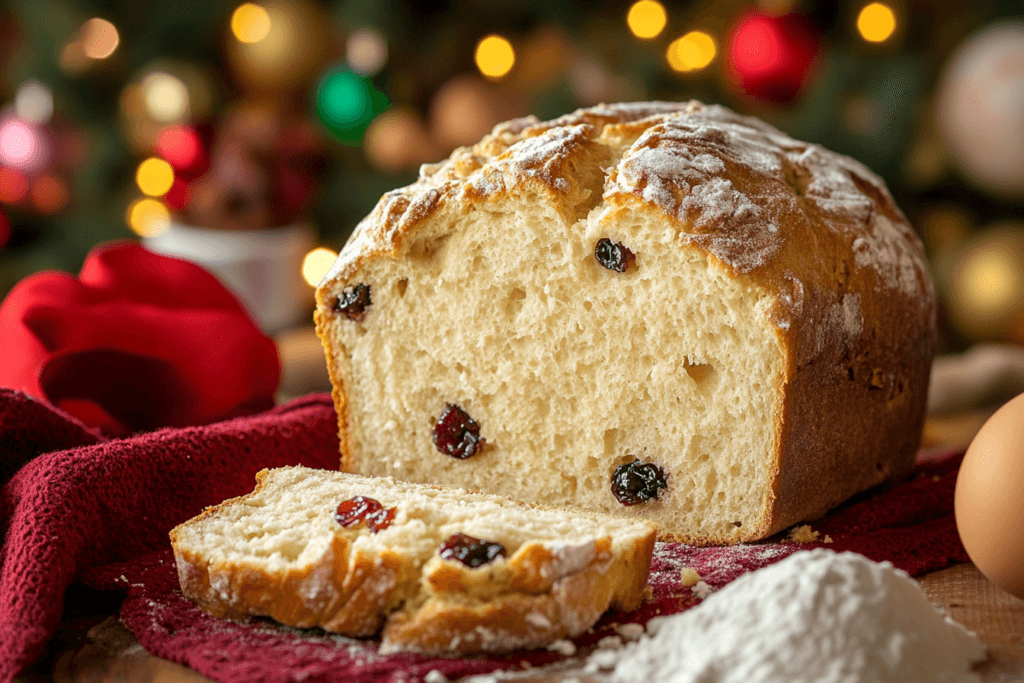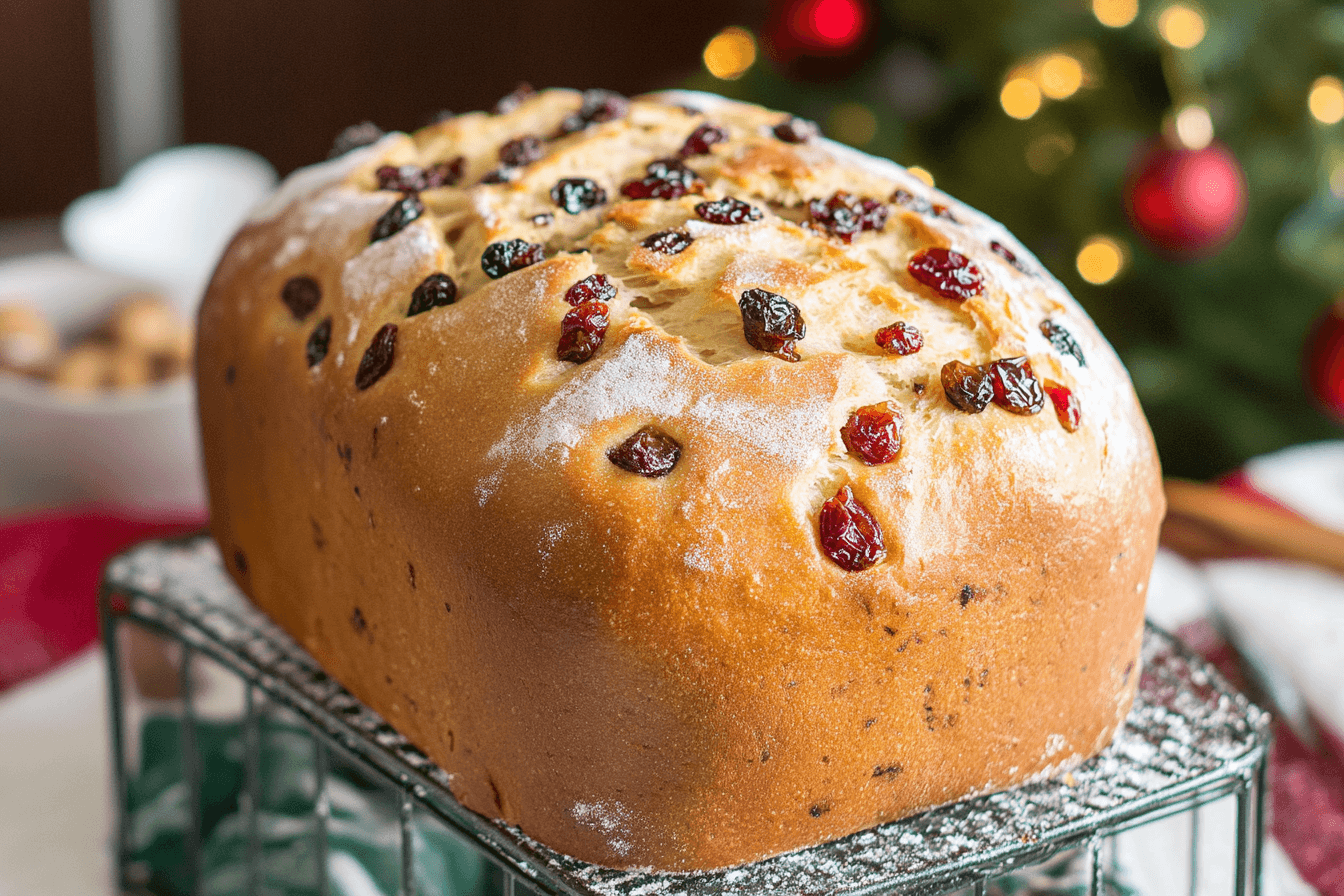Christmas is a time for family gatherings, holiday parties, and of course, indulgent food. While many of us think of desserts like pies, cookies, and cakes when it comes to holiday baking, there’s something special about Christmas bread. Whether you’re looking for a traditional loaf to serve on Christmas morning or a beautiful centerpiece for your holiday table, this Christmas bread recipe is sure to add festive cheer to any occasion.
This article will show you the step-by-step process of making homemade Christmas bread. From the ingredients to the baking techniques, we’ll also explore some delicious variations and creative ways to personalize this festive treat.
Table of Contents
What is Christmas Bread?
Christmas bread refers to an array of festive holiday loaves cherished worldwide. These breads are typically made with rich, buttery dough and enhanced with sweet fillings, as well as decorative elements like candied fruits, nuts, or spices. Different cultures have their own interpretations of Christmas bread, often baked in anticipation of Christmas Eve or Christmas Day.
For example:
- Stollen, a German bread, is packed with dried fruits and marzipan and dusted with powdered sugar.
- Panettone, an Italian Christmas bread, is light and fluffy and filled with candied fruits and raisins.
- Krantz cake (or Babka), popular in Eastern Europe, is a braided loaf with sweet fillings like chocolate or cinnamon.
The Significance of Christmas Bread
In many cultures, Christmas bread is more than just a food item—it symbolizes warmth, togetherness, and celebration. In some traditions, families bake and share a special loaf to bring good fortune and blessings for the upcoming year. Whether it’s a loaf shaped like a wreath, a star, or a simple round loaf, the baking and sharing of Christmas bread is a cherished holiday ritual.
Why Make Christmas Bread at Home?
Making your own Christmas bread allows you to control the ingredients and tailor the flavor to your liking. The process itself can be a fun family activity, and there’s nothing quite like the smell of freshly baked bread filling your home during the holidays.
Classic Christmas Bread Recipe
Now that we’ve covered the background of Christmas bread, it’s time to dive into the recipe! Here’s a step-by-step guide to making a classic, rich, and buttery Christmas bread.
Ingredients
For this Christmas bread recipe, you’ll need the following ingredients:
- 3 cups all-purpose flour
- 1 packet of active dry yeast (2 ¼ teaspoons)
- ½ cup warm milk (about 110°F)
- ¼ cup sugar
- 1/2 teaspoon salt
- 2 large eggs
- ¼ cup unsalted butter (melted)
- 1 teaspoon vanilla extract
- 1 ½ teaspoons ground cinnamon
- ½ teaspoon ground nutmeg
- 1 cup dried fruits (raisins, currants, cranberries, or a mix)
- ½ cup chopped nuts (walnuts, almonds, or pecans)
- Zest of 1 orange (optional)
- 1 egg for egg wash (optional)
Instructions
Step 1: Activating the Yeast
To start, dissolve the sugar in the warm milk. Stir the mixture well to ensure the sugar completely dissolves. Then sprinkle the yeast over the surface of the warm milk and allow it to rest for about 5-10 minutes. You’ll know it’s ready when the mixture becomes frothy, indicating the yeast is alive and active.
Step 2: Mixing Dry Ingredients
In a separate bowl, whisk together the flour, salt, cinnamon, and nutmeg. If you’re using orange zest, this is the time to add it. The zest will add a refreshing citrus note to the dough, complementing the spices beautifully. Mix these dry ingredients thoroughly, ensuring that the cinnamon and nutmeg are evenly distributed.
Step 3: Combining Wet and Dry Ingredients
Once the yeast has activated and is bubbling, pour it into the center of the dry ingredients. Add the eggs, and vanilla extract melted butter. Stir the ingredients together with a wooden spoon until the dough begins to form. You may need to use your hands toward the end of this stage to incorporate all the flour.
At this point, the dough will be sticky, which is completely normal. If it feels too wet, sprinkle in a little more flour, but be cautious not to add too much, as this can lead to dense bread.
Step 4: Kneading the Dough
Lightly dust a clean surface with flour and transfer the dough onto it. Begin kneading it by pushing it down and away from you with the heels of your hands, folding it back toward you, and repeating this motion. Knead the dough for about 8-10 minutes. It should gradually become smooth and elastic. You can test the dough’s readiness by pressing it with your finger—if it springs back, it’s ready.
Step 5: Adding Fruits and Nuts
This step is where you can get creative. Once your dough is smooth and elastic, it’s time to fold in the dried fruits and nuts. Gently flatten the dough with your hands, then sprinkle the dried fruits (such as raisins, currants, or cranberries) and chopped nuts (like almonds, walnuts, or pecans) over the dough. Fold the dough over to incorporate the add-ins. Be careful not to overwork the dough, as you want to keep the dried fruits and nuts intact.
Step 6: First Rise
Place the dough in a lightly greased bowl. Cover it with a clean kitchen towel or plastic wrap, and let it rise warmly for 1 to 1 ½ hours. The dough should double in size. If you have trouble finding a warm spot, preheat your oven to 200°F for a few minutes, turn it off, and place the dough inside to rise.
Step 7: Shaping the Dough
Once the dough has doubled in size, punch it down gently to release the air. Turn it out onto a floured surface. If you want to shape it into a traditional round loaf, simply tuck the edges underneath to form a ball. For a braided loaf, divide the dough into three equal portions, roll each piece into a long rope, and braid them together. Pinch the ends to seal, and place the braided loaf on a parchment-lined baking sheet.
Step 8: Second Rise
Cover the shaped dough again and allow it to rise for another 30 minutes. This second rise is crucial to ensure the finished loaf’s light, airy texture. As the dough rises, set your oven to preheat at 350°F (175°C).
Step 9: Brushing with Egg Wash (Optional)
If you’d like your bread to have a golden, glossy finish, brush the top of the dough with a lightly beaten egg. This step also helps seal moisture, ensuring your bread stays fresh longer.
Step 10: Baking the Bread
Place the dough in the oven and bake for 30-35 minutes. The bread should be golden brown and sound hollow when tapped on the bottom. Use a thermometer to ensure the internal temperature of the bread reaches approximately 190°F (88°C) for perfect doneness. This ensures the bread is fully cooked.

Variations of Christmas Bread
Now that we’ve covered the classic Christmas bread recipe in detail, let’s look at some delicious variations. These are perfect for experimenting with different flavors, textures, and fillings. Whether you’re catering to your family’s tastes or trying something new for the holidays, these variations will keep your Christmas baking fresh and exciting. If you are looking for an alternative bread recipe with a sweet taste, why not give The Ultimate Guide to Vegan Banana Bread a try?
Stollen-Style Christmas Bread
Stollen is a traditional German Christmas bread, and it’s a great variation if you’re looking for a rich, fruit-filled loaf. In addition to the dried fruits, you can add marzipan or almond paste to the center of the dough for a decadent surprise. You’ll also need to dust the finished loaf with powdered sugar for an authentic look.
Panettone Christmas Bread
Panettone is a traditional Italian Christmas bread that is light and fluffy, often filled with candied fruits, raisins, and citrus zest. To create your own Panettone-inspired loaf, replace the dried fruits in the classic recipe with a mixture of candied orange peel, raisins, and chopped almonds. Consider adding a teaspoon of lemon zest for extra brightness.
Chocolate-Stuffed Christmas Bread
For those who love a little chocolate, a Nutella or chocolate-stuffed Christmas bread is a real treat. You can spread Nutella or melted chocolate on the dough before rolling it up and shaping it. The resulting loaf will be filled with gooey, sweet chocolate inside—a perfect dessert or treat after a holiday meal.
Cinnamon Swirl Christmas Bread
If you’re craving something sweet and spicy, the cinnamon swirl version of Christmas bread is a must-try. Simply roll out the dough, spread a mixture of cinnamon, sugar, and butter over the surface, and then roll it up into a log. Slice the log into pieces, place them on the baking sheet, and bake. This creates beautiful spirals of cinnamon in each slice, ideal for serving at breakfast or as a dessert.
Vegan Christmas Bread
For those following a vegan diet, it’s easy to modify this recipe. Replace the butter with plant-based margarine and the eggs with a flaxseed mixture or applesauce. You can also use almond or soy milk instead of dairy milk. The result is a soft, sweet vegan Christmas bread that everyone can enjoy.
Tips for Perfect Christmas Bread
Use Fresh Ingredients
For the best flavor and texture, make sure your yeast is fresh, and your flour hasn’t been sitting in the pantry too long. Fresh ingredients ensure that the bread rises well and develops a rich, delicious flavor.
Knead the Dough Properly
Kneading is key to developing the structure of the bread. Don’t skip this step! Knead until the dough is smooth and elastic, which will help create that soft, pillowy texture we all love.
Let the Dough Rise Completely
It’s tempting to rush the rising process, but giving the dough enough time to rise will result in a fluffier, lighter loaf. Allow the dough to double in size during both rises for the best result.
Don’t Overbake
Keep an eye on the bread while it’s baking to avoid overbaking. If the top of the loaf begins to brown too quickly, cover it with aluminum foil and continue baking until fully cooked.
How to Serve and Enjoy Christmas Bread
Christmas bread is incredibly versatile and can be enjoyed in many ways. Here are some serving suggestions:
- As a Breakfast Loaf: Serve slices of your Christmas bread with butter, jam, or cream cheese for a simple, comforting breakfast.
- With Hot Drinks: Pair your bread with a cup of hot cocoa, coffee, or tea for a cozy holiday treat.
- As a Gift: Christmas bread makes an excellent homemade gift. Wrap it in festive paper or place it in a decorative tin for a thoughtful and delicious present.
- With Cheese and Fruit: For a more savory option, serve your Christmas bread with cheese and fruit as part of a holiday charcuterie board.
Conclusion
Christmas bread recipe is not just a treat—it’s an experience. The process of making this rich, flavorful bread brings the family together and fills the house with the warm, comforting smells of the season. Whether you choose to make the classic version or explore creative variations, this recipe is sure to become a holiday tradition for years to come.
By incorporating the tips and variations outlined in this article, you can craft a festive masterpiece that will impress your guests and add a special touch to your holiday celebrations.

